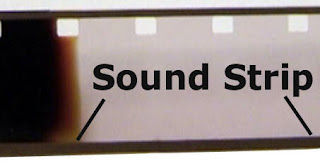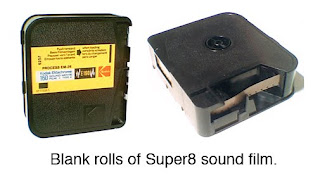Ever wonder if the old home movies you've been holding onto all these years have sound on them?
There are many different film formats that have been used in the US over the years for both commercial film production and consumer home movies. The most popular are Regular 8mm film, Super8mm film, and 16mm film. All three film types may or may not be recorded with sound. Prior to the advent of Regular 8mm film in the 1930's, home movies were shot on silent 16mm film, but this was expensive. In 1932 the Eastman Kodak company released the Cine Kodak Eight which used Regular 8mm film (also known as standard 8mm film). Regular 8mm film is similar to 16mm film except that it is only 8mm wide and only has sprocket holes on one side whereas silent 16mm film has sprocket holes on both sides.
Super 8mm film came later as a technical innovation. The sprocket holes were made narrower so the frame size of the film could be larger, thus increasing image quality and sharpness. Below are what the silent versions of these film sizes look like.
However, the sound versions of these films are all quite different. While
Regular 8mm film could have sound added to the film during the processing phase at a film lab, there were no 8mm cameras that recorded audio onto film while it was being shot. During processing at a film lab, a magnetic strip (much like the magnetic tape in an audio cassette) was glued to the edge where the sprocket holes were to enable narration or music recording after the fact. This was called sound striping. There were also projectors that could record music and narration over the film, but not a
synchronized audio track recorded at the time of filming.
This changed in the 1960's when Super8mm film came out. Since the magnetic strip on Super8mm was on the opposite side of the sprocket holes, a sound head in the camera could easily record audio at the time of shooting. Below is a diagram and a picture comparing Regular 8mm sound film to Super8mm sound film.
Regular 8mm film with sound is very rare, but Super 8mm sound is more common. However, most of your relatives probably shot silent film because both the cameras and film capable of recording sound were far more expensive. Super 8mm sound film has not been manufactured for over a decade, and there are virtually no labs left that will process it. As opposed to Regular8mm sound film, Super8mm's sound strip was not glued on during processing.
Magnetic strips on film, especially strips that were pasted on after processing, have been known to fall off of the film due to the glue wearing out. That's why it's very important to have your
Super 8mm film digitized as soon as possible to preserve film and the films soundtrack.
So, how do you tell if your Regular 8mm or Super 8mm has sound? Just roll out approx. five feet of film and look for these magnetic tracks. If you don't want to unwind your film and expose it to dust, you can simply look at the side of your film reel for the copper color of the magnetic track.
Regular8mm film and Super8 had what is called a balance stripe. We won't go into what it's for, but it's a narrower magnetic stripe located on the other side of the film with respect to the main one. Some projectors can actually read and record onto the balance stripe, so sometimes families would record music onto it, and it would play in tandem with the sound they recorded while filming. Typically, the balance stripe has no sound on it.
While most people shot 8mm and Super 8 film back in the 1950's and 60's, silent 16mm was used primarily for home movies in the 1940's and earlier. After Regular8mm came along, 16mm became a commercial format mostly...shot by independent filmmakers, television producers, and for the news.
There are two general kinds of 16mm soundtracks: magnetic and optical (shown below).
Like Regular 8mm sound film and Super8mm sound film, the magnetic track on 16mm is read like an audio cassette with a magnetic sound head. However, optical sound is quite different. Optical sound is literally an image of a sound waves located on the non-perforated side of the film. As light is shined through it, pulses of light are interpreted by a sensor in a projector which are then translated into an analog audio signal that can played out of a speaker.
Chances are none of your film is magnetic as magnetic 16mm film was primarily used for the news (they needed their sound on the film right away). In terms of optical soundtracks, they cannot be recorded by a camera, only added later by a lab. Usually, the only time you will have film that has an optical soundtrack will be when it's a commercially produced film, such as educational films meant for distribution to classrooms. Sometimes even, and this is especially true if your commercial film is from the UK, you'll see an optical soundtrack called a variable density soundtrack. It can be read by the same projector that can read a normal optical track. Below is a closeup of the track itself.
How can you tell whether your
16mm film has sound or not? Unwind the film past the leader (film of a solid color that is attached to the beginning the reel) and look for the spocket holes (perforations). If your film is double perforated; it has sprocket holes on both sides, then it is silent and most likely home movie footage. If it's single perforated; sprocket holes on one side only, then it's more likely to have sound. However, there is silent single perforated 16mm film, so after you unwind the film a bit, check directly for the soundtrack.
Remember, sound is just as important as your image and the older the film gets the worse the sound gets as well. By doing a high quality
film to video transfer at Audio Video Workshop, you will preserve not just your sound, but your film as well!
650-369-4366
Regular 8mm Film Conversion to Digital
16mm Film Transfer to DVD or Bluray












